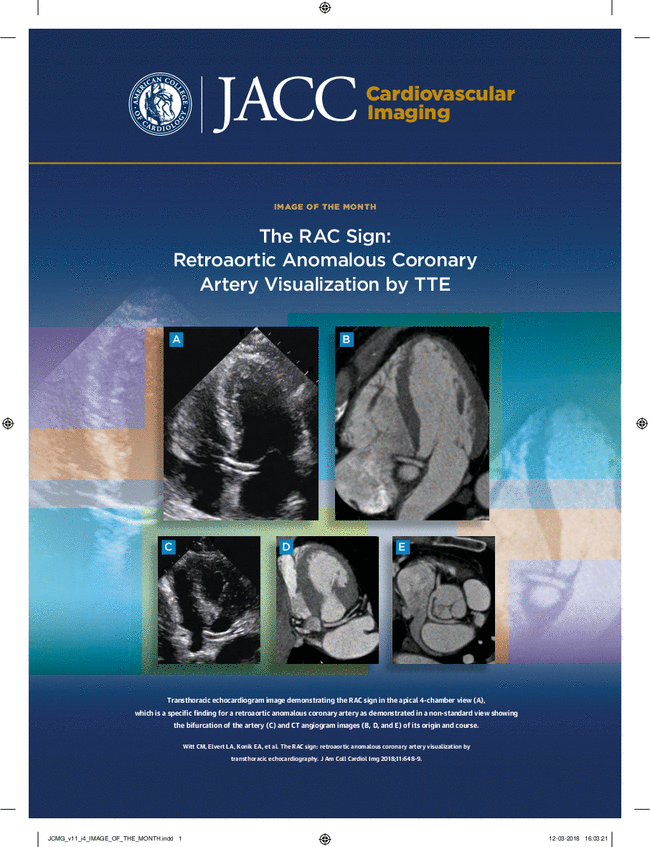慢性主动脉瓣反流的超声心动图评估:与心脏磁共振的比较及对指南建议的影响。
IF 15.2
1区 医学
Q1 CARDIAC & CARDIOVASCULAR SYSTEMS
引用次数: 0
摘要
背景:主动脉瓣反流(AR)的超声心动图评估指南尚未经过独立定量标准的验证:主动脉瓣反流(AR)的超声心动图评估指南尚未根据独立的定量标准进行验证:本研究旨在评估美国超声心动图学会(ASE)主动脉瓣反流指南与心脏磁共振(CMR)的准确性,并制定检测明显主动脉瓣反流的简化方法:AR患者接受超声心动图和CMR检查:作者研究了 81 名患者;中位年龄为 52 岁,58% 患有双尖瓣主动脉瓣。根据回波检查结果,35 例(43%)患者为轻度 AR,18 例(22%)为中度,12 例(15%)为中至重度,16 例(20%)为重度 AR。使用 ASE 分级通过 CMR 检测重度 AR 的曲线下面积 (AUC) 为 0.9(灵敏度为 82.4%,特异度为 96.9%)。使用任何一种回波容积法进行 RegV 定量的可行性都大于 88%,而近端等速表面积的可行性较低(37%)。回波参数与 CMR 比较,准确度最高的是静脉收缩宽度、射流宽度和 LV 舒张末期容积指数(AUC:0.86-0.89);压力半衰期的准确度最低。在没有RegV定量的情况下,收缩静脉宽度≥0.5 cm和左心室舒张末期容积指数≥82 mL/m2对通过CMR识别≥中度至重度AR具有95.5%的阳性预测值和87.5%的阴性预测值(AUC:0.89):结论:ASE指南在识别严重AR方面表现非常出色。使用收缩静脉宽度和左心室容积的简化方法可以可靠地鉴别出明显的 AR。需要在更大的队列中并根据临床结果进一步验证这些发现。本文章由计算机程序翻译,如有差异,请以英文原文为准。
Echocardiographic Evaluation of Chronic Aortic Regurgitation
Background
Guidelines for echocardiographic evaluation of aortic regurgitation (AR) have not been validated against an independent quantitative standard.
Objectives
The aim of this study was to evaluate the accuracy of the ASE (American Society of Echocardiography) AR guidelines against cardiac magnetic resonance (CMR) and to develop simplified approaches for detection of significant AR.
Methods
Patients with AR underwent echocardiography and CMR <4 hours apart. AR severity was graded according to ASE guidelines. Quantitation of regurgitant volume (RegV) was performed with pulsed Doppler at the mitral annulus and right ventricular outflow compared with left ventricular (LV) outflow, and with proximal isovelocity surface area.
Results
The authors studied 81 patients; median age was 52 years, and 58% had a bicuspid aortic valve. According to echo, 35 (43%) patients had mild AR, 18 (22%) moderate, 12 (15%) moderate to severe, and 16 (20%) had severe AR. The area under the curve (AUC) for detection of severe AR by CMR using ASE grading was 0.9 (82.4% sensitivity and 96.9% specificity). Feasibility of RegV quantitation was >88% using either echo volumetric method, and it was low for proximal isovelocity surface area (37%). The highest accuracy for echo parameters against CMR was seen with vena contracta width, jet width, and LV end-diastolic volume index (AUC: 0.86-0.89); pressure half-time had the lowest accuracy. Without RegV quantitation, a vena contracta width ≥0.5 cm and indexed LV end-diastolic volume ≥82 mL/m2 had 95.5% positive predictive value and 87.5% negative predictive value for identifying ≥moderate to severe AR by CMR (AUC: 0.89).
Conclusions
The ASE guidelines display very good performance in identifying significant AR. A simplified approach using vena contracta width and LV volumes can be used to reliably identify significant AR. Further validation of the findings in larger cohorts and against clinical outcomes is needed.
求助全文
通过发布文献求助,成功后即可免费获取论文全文。
去求助
来源期刊

JACC. Cardiovascular imaging
CARDIAC & CARDIOVASCULAR SYSTEMS-RADIOLOGY, NUCLEAR MEDICINE & MEDICAL IMAGING
CiteScore
24.90
自引率
5.70%
发文量
330
审稿时长
4-8 weeks
期刊介绍:
JACC: Cardiovascular Imaging, part of the prestigious Journal of the American College of Cardiology (JACC) family, offers readers a comprehensive perspective on all aspects of cardiovascular imaging. This specialist journal covers original clinical research on both non-invasive and invasive imaging techniques, including echocardiography, CT, CMR, nuclear, optical imaging, and cine-angiography.
JACC. Cardiovascular imaging highlights advances in basic science and molecular imaging that are expected to significantly impact clinical practice in the next decade. This influence encompasses improvements in diagnostic performance, enhanced understanding of the pathogenetic basis of diseases, and advancements in therapy.
In addition to cutting-edge research,the content of JACC: Cardiovascular Imaging emphasizes practical aspects for the practicing cardiologist, including advocacy and practice management.The journal also features state-of-the-art reviews, ensuring a well-rounded and insightful resource for professionals in the field of cardiovascular imaging.
 求助内容:
求助内容: 应助结果提醒方式:
应助结果提醒方式:


